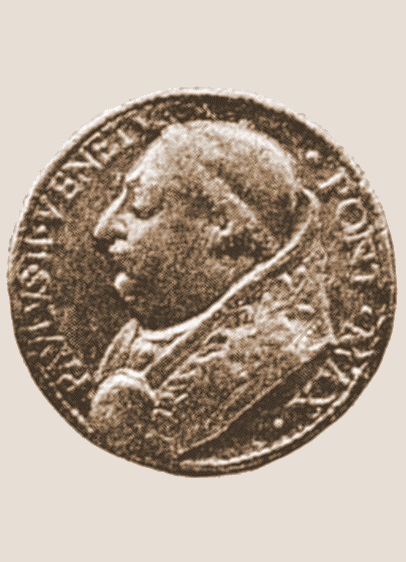Paul II
August 30, 1464 - July 26, 1471
BACKGROUND
Family and Birthplace
Pope Paul II, who was the nephew of Pope Eugene IV, began life in Venice as Pietro Barbo.
Advancement
Pietro was 23 when his uncle named him to the important post of cardinal-deacon. Under Nicholas V, he was named cardinal-priest of San Marco, a post that was traditionally assigned to a Venetian. His career advanced rapidly, and he received many benefices (offices endowed with regular incomes) over the years. By the time he was elected pope, he had become very wealthy.
INTERNATIONAL POLITICAL PROBLEMS
Turkish Expansion
In response to the expansion of the Ottoman Empire into Europe, Pope Paul tried to persuade the principal powers of Europe to mount a crusade against the Turks, but in this, he was no more successful than his papal predecessors.
Attempted Unification with Eastern Church
Like his papal uncle, Pope Eugene IV, Paul II attempted to unify the two branches of the Church, the Roman Catholic Church and the Eastern Orthodox Church. Part of the plan involved a marriage between the Catholic daughter of John VIII Palaeologus, the Byzantine emperor, and Ivan III of Russia, but Pope Paul died suddenly, and nothing was done.
Conflict with Bohemian King
In trying to convince the King of Bohemia (an area that today forms part of the Czech Republic) to join a crusade, their relationship worsened and almost resulted in a war. In the end, the pope excommunicated the king for heresy.
PAPAL POLICY WITHIN THE CHURCH
Campaign against Paganism
Although Pope Paul was devoted to the scholarly study of ancient manuscripts, he objected to the literature that concerned paganism. To this end, he abolished the Roman Academy and banned the study of ancient Roman poetry for children.
Firing and Imprisonment of Humanists
As part of his anti-paganism, Paul abolished the College of Secretaries, which was a branch of the Chancery office. Its staff included many humanists, among them Alberti, who had been appointed by Pius II.
The papal historian Bartolomeo Platina criticized the pope's decision and defended humanism, which prompted the pope to imprison him.
Maintenance of Papal Autonomy
Pope Paul resisted efforts to limit papal authority both within the Church and abroad.
Within the Church, he squashed an initiative by the college of cardinals to subject papal policies to review by a larger body in a constitutional relationship.
Internationally, Paul managed to convince the French king to put aside a French resolution that limited the pope's authority over the French Church.
CULTURAL INTEREST AND ACTIVITIES
Collecting Precious Objects
Paul collected precious objects of a variety of types. He acquired Flemish tapestries, Florentine gold work, carved ivory, and precious gems. Paul's collection of small objects from antiquity included cameos, carved gemstones, gold and silver coins, and bronze statuettes. Much of his collection was later acquired by Lorenzo de' Medici.
Printing Press
Pope Paul sponsored the purchase and operation of the first printing press in Italy, which was set up in 1467 at the Benedictine monastery at Subiaco near Rome. The new press from Germany was operated by German printers that Nicholas of Cusa had encouraged to emigrate.
PROMOTION OF CHURCH PRESTIGE
Jubilees and Pageantry
Paul loved pomp and spectacle, and he used ceremonial events as a means of promoting the Church's prestige.
Building on the 1450 Jubilee declared by Pope Nicholas V, Paul instituted a Jubilee every 25 years. His death at age 54 prevented his own participation in the 1475 occasion, which took place four years later.
Restoration of Rome
Like Pope Nicholas V, who began a large-scale program of repairing and rebuilding Rome, Pope Paul believed that restoring the city to the magnificence it enjoyed during the era of the Roman Empire would enhance the Church's prestige, attract pilgrims and their gifts to the Church, and underscore Rome as the rightful seat of the papacy, a point that needed to be emphasized in the wake of the Great Schism.
In addition to addressing structures of religious or practical significance, Paul initiated the repair of ancient Roman monuments like the Pantheon, the Arch of Titus, and the Arch of Septimius Severus.
Architectural Commissions
Paul sponsored the continuation of recent unfinished projects like the Benediction Loggia at the Vatican and the initiation of new ones like the enlargement of the Palazzo Venezia.
♦Benediction Loggia, Vatican, 1461-95. Pope Paul continued the construction of the Benediction Loggia at the Vatican. This structure's use of superimposed arcades ornamented by the orders served as a model for two similar arcades at Paul's main project, the Palazzo Venezia.
♦Palazzo Venezia, Rome, 1455-1503. Pope Paul built the Palazzo Venezia in two phases. As Cardinal Barbo, whose titular church was San Marco, he commissioned part of the east wing, the tower, and the Palazzetto, which was a two-story loggia that enclosed a private garden and joined a suite of rooms. As Pope Paul II, he enriched its decoration and expanded the complex by adding five more bays to the east wing, a second, longer wing at a right angle to the first, a two-story arcaded loggia to the front of the church, and part of a courtyard on the palace's inner facing. The courtyard's vocabulary of piers embellished by engaged columns reflected models like the Theater of Marcellus and the Colosseum as well as the more recent Benediction Loggia, which was still under construction.




 Add Placemark
Add Placemark Go Back
Go Back 




